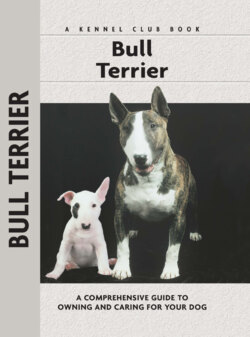Читать книгу Bull Terrier - Bethany Gibson - Страница 6
На сайте Литреса книга снята с продажи.
ОглавлениеA Bull Terrier was the pet of the famed actress Miss Jean Melville. This photo was taken circa 1932.
Why the Bull Terrier was developed back in England in the 1800s has very little to do with today’s Bull Terrier. The Bull Terrier is based on bull-and-terrier dogs, which were bred for baiting and dog fighting, sports that were eventually outlawed in Great Britain in the 19th century. These early dogs were bred for function, not form, and were completely devoted to their owners.
The extinct English White Terrier, an acknowledged forerunner of today’s Bull Terrier. Photograph by C. Reid, circa 1890.
The origin of the Bull Terrier breed can be traced directly to a man named James Hinks, of Birmingham, England, who after years of experimentation introduced the breed in the 1850s. The Bull Terrier is based loosely on the now-extinct English White Terrier. Hinks spent years crossbreeding with bull-and-terrier dogs, attempting to build a bulldog that was not only better fitted to the pits but also better looking. By breeding out some traits seen in many early pit-fighting dogs, such as the roach back, overly angulated legs and undershot jaw, and injecting some size and strength (possibly from crossbreeding with the Spanish Pointer), the result was a handsome, proud gladiator, fit to walk next to a gentleman. The Bull Terrier retained a positive attribute of its bull-and-terrier predecessors—unmatched loyalty to his owner.
If there was any question that the Bull Terrier was “too pretty” for the dog pits, the myth was quickly dispelled. The feisty, fight-to-the-death spirit of the Bull Terrier made him a relentless fighter in the pits, often beating dogs almost twice his size. Legend has it that Hinks himself once matched his 40-lb bitch Puss of Brum against the never-wary Mr. Tupper’s 60-lb bull-and-terrier cross. Not only did “Puss” emerge victorious from the bloody bout, but Hinks whisked her away to the Holborn dog show later in the day—where she won a red ribbon!
The Bull Terrier was also quite a rat fighter, another unusual blood sport that was quite popular in England. Bull Terriers held the unofficial records for most rats killed in minutes, hours and other time frames.
Noted English breeder of the 1930s, Mrs. Adlam, with her Bull Terriers, Ch. Brendon Gold Standard, Ch. Brendon Beryl and Boomerang.
Bull Terriers depicted in an engraving from the end of the 19th century. Note the dramatic differences in the head style and length of leg, compared to our modern Bull Terriers.
Though Hinks was quite proud of his creation’s success in the dog- and rat-fighting pits, he was more interested in winning at the dog shows, which were beginning to rival dog fighting in popularity in Britain. In the 1860s, dog fanciers and show judges became partial to the all-white Bull Terriers; as a result, Hinks set forth to create a more consistently all-white breed. By culling piebald and brindle pups, breeding white dogs to white bitches and possibly introducing Dalmatian blood, Hinks was successful in creating all-white Bull Terriers. To this day, however, both types remain, classified as two varieties of the same breed, White and Colored Bull Terriers in the US and as one breed in the UK.
From 1907, this Bull Terrier bitch, known as Millstone Venus, exhibits the changing fashion in breed type. She is much slighter and higher on leg, with a longer, nearly elegant neck.
Throughout England, it became fashionable for gentlemen to sport Bull Terriers at their sides. Fearless, strong, loyal, well-mannered and friendly, the Bull Terrier was a stylish addition to the gentle-man’s retinue and became known as the “White Cavalier.” The Bull Terrier’s acceptance in upper-class society and success in the dog-show circuit were blessings, as the breed became known more as a people’s dog than a fighting dog, eventually resulting in the friendly and typically peaceful Bull Terrier we know today.
